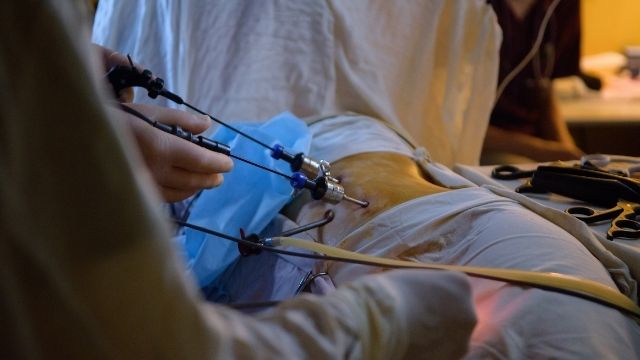Laparoscopic surgery

Laparoscopic Surgery
1- Endoscopy is a procedure that lets your doctor look inside your body.
2- It uses an instrument called an endoscope, or scope for short.
3- Scopes have a tiny camera attached to a long, thin tube.
4- The doctor moves it through a body passageway or opening to see inside an organ. Sometimes scopes are used for surgery, such as for removing polyps from the colon.
2- It uses an instrument called an endoscope, or scope for short.
3- Scopes have a tiny camera attached to a long, thin tube.
4- The doctor moves it through a body passageway or opening to see inside an organ. Sometimes scopes are used for surgery, such as for removing polyps from the colon.
What are laparoscopic surgeries ?
Endoscopy is a procedure that lets your doctor look inside your body.
It uses an instrument called an endoscope, or scope for short.
Scopes have a tiny camera attached to a long, thin tube.
The doctor moves it through a body passageway or opening to see inside an organ.
Sometimes scopes are used for surgery, such as for removing polyps from the colon.
There are many different kinds of endoscopy.
Here are the names of some of them and where they look :
Colonoscopy and sigmoidoscopy : large intestine.
Cystoscopy and ureteroscopy : urinary system.
Laparoscopy : abdomen or pelvis.
Upper gastrointestinal endoscopy : esophagus and stomach.
Laparoscopy vs. laparotomy :
Before the laparoscopic method came along, a surgeon who operated on your belly or pelvic area had to do open surgery called laparotomy, where a 6- to 12-inch-long cut was made through the abdominal wall.
This larger opening gave the surgeon enough room to see what they were doing and reach whatever they had to work on inside your body.
Laparoscopy is known as a minimally invasive surgery (MIS) because it uses smaller cuts.
Doctors first used it for gallbladder surgery and gynecology operations.
Then it came into play for the intestines, liver, and other organs.
While a laparoscopy has a shorter recovery time than a laparotomy, it can take longer and require special training and tools.
In some cases, such as an emergency, a laparotomy might be more appropriate.
Types of Laparoscopy A variety of surgeries can be done laparoscopically, including :
Adrenal gland removal.
Appendectomy.
Cancer Cyst, fibroid, stone, and polyp removals.
Esophageal surgery.
Gallbladder removal.
Gastric bypass surgery.
Hernia repair surgery.
Kidney removal.
Prostate removal.
Rectal prolapse repair.
Rectum removal.
Removal of part of the bowel.
Removal of part of the liver.
Small tumor removals.
Spleen removal.
Stomach removal.
Urethral and vaginal reconstruction surgery.
Doctors also use laparoscopic surgery to help diagnose patients if the results of imaging tests such as CT, MRI, and ultrasound aren’t clear.
The laparoscopy allows doctors to take a better look at an area of concern.
They can also use it to look for the cause of belly or pelvic pain.
Preparing for Laparoscopy :
Your doctor will let you know what’s required before your laparoscopy.
Share all the medications you are taking with your doctor.
You may need to stop taking certain medications before surgery. Some of these medications include :
Anticoagulants, such as blood thinners.
Nonsteroidal anti-inflammatory drugs (NSAIDs), including aspirin (Bufferin) or ibuprofen (Advil, Motrin IB).
Other medications that affect blood clotting.
Herbal or dietary supplements.
Vitamin E.
Because the small incisions will be around your waist, plan to wear loose-fitting clothes that won’t rub or irritate as you heal after surgery.
You also can’t eat or drink for 8 hours before the surgery.
Laparoscopy Procedure
Before your laparoscopy, you might have to take imaging or blood and urine tests.
You’ll have an IV inserted into a vein so you can receive fluids, pain medications, and anesthesia during the procedure.
Doctors will also put a breathing tube down your throat to make sure your airway stays open.
You might have a urinary catheter inserted, and then your skin will be cleaned with a disinfectant solution.
